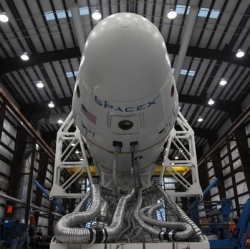
SpaceX understands that the key to reducing launch costs is to minimize the degree to which hardware is thrown way. The first stage, with its nine engines, is reportedly about 70% of the total vehicle cost, and the easiest part to recover, in theory.
What had to go right this weekend for them to land the stage intact? First, after stage separation, it would have to relight three of its nine engines to slow down from about 3000 mph to an entry speed that wouldn’t break up the vehicle. After entry, another three engine relight would have to occur to aim the vehicle toward the drone ship on which it was planned to land, and fins would be deployed to help steer it. Finally just before landing, a relight of a single engine would be required for a soft landing, with guidance continuing to be aided by the fins. It would be the most precise flight ever achieved (previous water landings hadn’t been particular about location).
With the exception of the final landing itself, almost everything went according to plan. The vehicle entered intact, flew to the ship, and (apparently literally) hit the deck, because the hydraulic fluid that controlled the fins ran short by 10% of that needed to control and softly land. But in so doing, it accomplished another major “first,” not just for a private company, but for any space ship. Previous Falcon flights had demonstrated the ability to enter the stage intact by retrothrusting (as opposed to simply braking against the atmosphere), but this was the first time such a vehicle had not only survived entry, but flown precisely to a pre-designated location, without wings.
If they succeed later this month, it will be another huge first: the first time that a spaceship has landed on earth since the last Shuttle retired, and the first time any spaceship has landed on earth vertically, using only propulsion. The next step will be to determine how much it will take to reliably (and rapidly) reuse the stage. If the answer is “not much,” it will mean a revolution in reducing the cost of access to space. SpaceX’s competitors are watching carefully.
CNES, the company that builds Europe’s Ariane, recently announced its own project to make its vehicles reusable, though not for many years. Tory Bruno, the new CEO of the United Launch Alliance, which operates the Atlas and Delta launch systems, will be announcing the company’s plans for its own new launch systems next month, and many (including me) will be surprised if reusability isn’t a key part of them.
